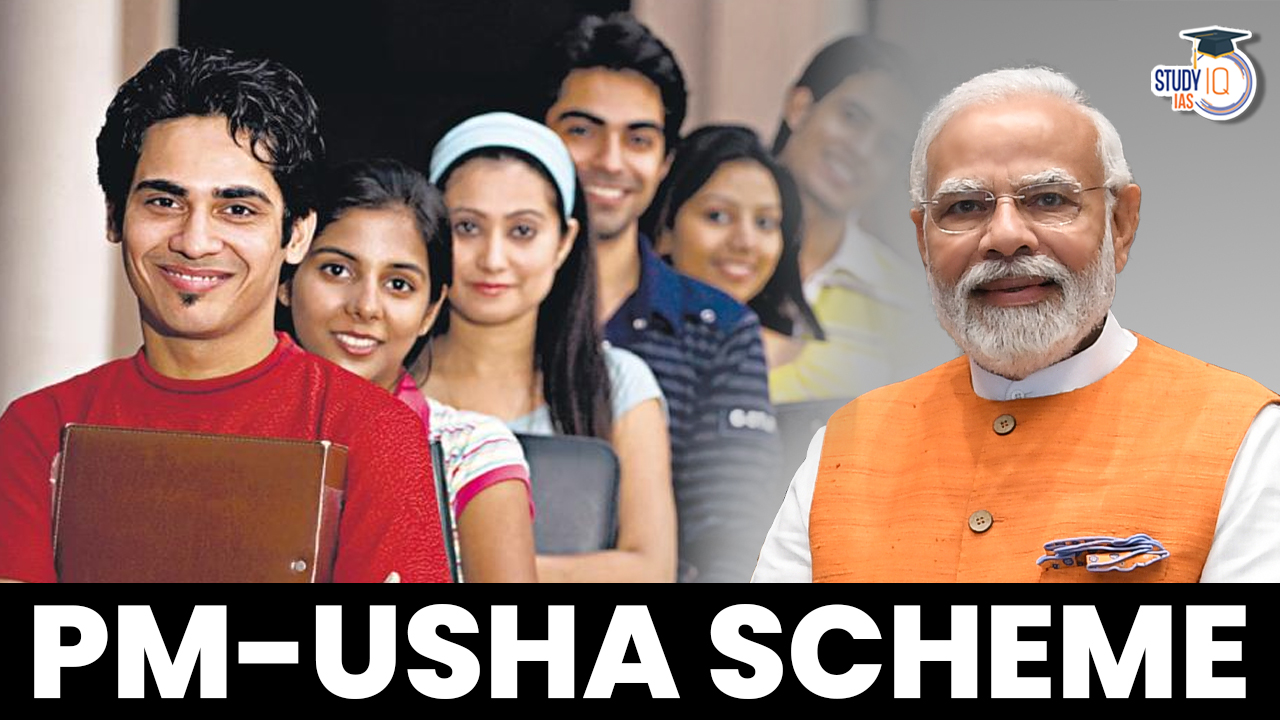Table of Contents
PM-USHA Scheme
PM-USHA is a centrally sponsored scheme under the Ministry of Education to enhance the quality and accessibility of higher education across the country. The aim of the PM-USHA Scheme is at improving the curriculum, teachers’ training, infrastructure, accreditation, and employability. Focus on ensuring equity, access, and excellence in higher education across States and Union Territories. The fund allocated to the PM-USHA Scheme is ₹12,926.10 crore for 2023-24 to 2025-26.
PM-USHA Scheme Overview
The PM-USHA program seeks to give States financial assistance for enhancing their higher education systems. According to the rules announced in June 2023, States and Union Territories are required to sign an agreement with the Department of Higher Education (MoU) pledging to implement National Education Policy 2020 and adopt rules for the National Credit Framework and Choice-Based Credit System for a Four-Year Undergraduate Program.
Despite the requirement for a 40% financing contribution from State governments, these requirements act as a precondition for accessing the 12,926.10 crores provided between 2023–24 and 2025–26. Check the overview of the PM-USHA Scheme below in the table:
| Particulars | Details |
| Name of the Scheme | Pradhan Mantri Uchchatar Shiksha Abhiyan (PM-USHA) |
| Initially launched as | Rashtriya Uchchatar Shiksha Abhiyan (RUSA) in 2013 |
| Renamed as PM-USHA | June 2023 |
| Scheme Type | Centrally Sponsored scheme |
| Ministry | Ministry of Education |
| Purpose of PM USHA Scheme | To enhance the quality and accessibility of higher education across the country |
| Scheme is Aligned with | National Education Policy 2020 |
| Funding | 90:10 ratio for certain states and 60:40 for others, while UTs without Legislature receive 100% central funding. |
| Eligibility criteria to get PM-USHA funding | The colleges of any discipline under the Section 2(f) of the UGC Act are eligible for the funds. At least 10 years of active administration is required. The colleges must have grade A of NAAC accreditation or a good NBA score. |
Background of Pradhan Mantri Uchchatar Shiksha Abhiyan (PM-USHA)
The Rashtriya Uchchatar Shiksha Abhiyan (RUSA) was an initiative in the form of a Centrally Sponsored Scheme aimed at providing funding to educational institutions in States and Union Territories. Its primary objective was to enhance accessibility, equity, and quality within the state-level higher education system, while also emphasizing efficiency, transparency, accountability, and responsiveness.
The scheme was initiated in two phases: The first phase was inaugurated in 2013, followed by the launch of the second phase in 2018. With the advent of the National Education Policy, the RUSA scheme has been revitalized and rebranded as the Pradhan Mantri Uchchatar Shiksha Abhiyan (PM-USHA).
| Background of PM-USHA Scheme | ||
| Aspect | RUSA (Before Renaming) | PM-USHA (After Renaming) |
| Name | Rashtriya Uchchatar Shiksha Abhiyan (RUSA) | Pradhan Mantri Uchchatar Shiksha Abhiyan (PM-USHA) |
| Renamed Year | 2013 | June 2023 |
| Type | Centrally Sponsored Scheme | Centrally Sponsored Scheme |
| Objective | Enhance quality in higher education institutions, ensure compliance with norms and accreditation standards, foster governance and academic reforms, and encourage research and innovation. | Enhance quality in higher education institutions, ensure compliance with norms and accreditation standards, foster governance and academic reforms, and encourage research and innovation. |
| Focus | Transformation, quality, equity, innovation, research, employability | Transformation, quality, equity, innovation, research, employability |
| Key Features |
|
|
| Purpose | Strategic funding for higher education institutions nationwide | Strategic funding for higher education institutions nationwide |
| Alignment | N/A | In alignment with the National Education Policy |
| Primary Beneficiaries | Higher education institutions | Higher education institutions |
| Funding Source | Central and State Governments | Central and State Governments |
| Implementation Period | Launched in October 2013 | Continuation from RUSA, renamed in June 2023 |
| Significance | Laid the foundation for enhancing higher education quality and accessibility | Continued efforts to transform higher education, in line with NEP, promoting quality, equity, and innovation |
Need of PM-USHA Scheme
RUSA 1.0 & 2.0 has addressed around 2500 institutions, enhancing access, equity, and quality through 16 components. Notable progress in higher education indicators like Gross Enrollment Ratio (GER), Quality Reforms through Accreditation, and Student-Teacher ratio has been achieved. However, gaps persist in access, inclusion, enrollment, quality improvement, skill development, employability, and technology integration.
Hence, fresh interventions are necessary for bridging these gaps, yielding improved results. PM-USHA aims to rectify key gaps identified in the NITI Aayog’s Evaluation Report of Centrally Sponsored Schemes. The report recommends:
- Redesigning the scheme for rationalization and higher impact.
- Focusing on graduate employability by funding market-linked courses, industry connections, and student internships.
- Thoroughly tracking HEI employability outcomes.
- Introducing skill-based education, addressing critical gaps, and offering vocational courses.
- Promoting technology and Open Distance Learning for enhanced access and quality.
- Supporting institutes to boost NAAC accreditation grades, emphasizing quality initiatives, e-learning adoption, and outcome tracking.
- Encouraging community participation, gender sensitization, and more.
Objectives of PM-USHA Scheme
Check the Objectives of PM-USHA Scheme below:
- Enhance the quality of existing state higher education institutions by ensuring their alignment with defined standards and adopting accreditation for quality assurance.
- Catalyze transformative changes in state-level higher education by establishing a supportive institutional framework for planning, monitoring, promoting university autonomy, and enhancing governance.
- Implement the recommendations of the National Education Policy 2020 by offering financial backing to state higher education institutions.
- Initiate governance, academic, examination, and evaluation reforms in state-level higher education institutions, fostering connections with both school education and the job market to promote self-reliance and foster an Atma-Nirbhar Bharat (self-reliant India).
- Cultivate an environment conducive to research and innovation within higher education institutions.
- Address regional disparities in access to higher education by ensuring quality institutions are available in urban, semi-urban, rural, and underserved areas.
- Develop infrastructure for Open, Online, and Digital Learning (ODL) methods in states and union territories.
- Promote equity in higher education by ensuring marginalized groups, including women, minorities, SC/ST/OBCs, and differently-abled individuals, have sufficient opportunities.
- Enhance employability through skill development and vocational training.
- Establish New Model Degree Colleges in districts without government or government-aided institutions.
- Prioritize areas with low Gross Enrollment Ratio (GER), Left Wing Extremism (LWE) zones, border regions, aspirational districts, and districts with higher SC/ST populations.
- Emphasize multidisciplinary education encompassing STEM, commerce, and humanities disciplines.
Institutional Framework of PM-USHA Scheme
PM-USHA’s implementation and oversight are facilitated by a structured system of entities with distinct roles and authorities at the Central, State, and institutional tiers.
Central Level Structure
At the central level, there are four principal bodies:
- National Mission Authority (NMA): Chaired by the Hon’ble Education Minister of the Government of India, NMA provides high-level guidance and oversight.
- Project Approval Board (PAB): Headed by the Secretary (Higher Education), GoI, PAB approves project proposals, funding allocations, and major decisions.
- National Project Directorate (NPD): Responsible for executing and coordinating project activities on a national scale.
- Technical Support Group (TSG): Provides technical expertise and guidance to ensure effective project implementation.
State Level Structure
The state-level structure comprises three key entities:
- State Higher Education Council (SHEC): Responsible for policy formulation, coordination, and overseeing higher education within the state.
- State Project Directorate (SPD): Manages and oversees the project’s implementation at the state level.
- State Technical Support Group (State-TSG): Offers technical assistance and advice at the state level.
Institutional Level Structure
Within institutions, the project is managed by two main bodies:
- Board of Governors (BOGs): Within each institution, the BOG manages the institution’s affairs, including project implementation.
- Project Monitoring Unit (PMU): Monitors and supervises the project’s progress at the institutional level, ensuring adherence to objectives and timelines.
This hierarchical structure ensures effective coordination, streamlined communication, and efficient execution of the PM-USHA initiatives across different levels of governance.
Funding Support for PM-USHA Scheme
- PM-USHA is funded by the Ministry of Education, with contributions from States and Union Territories. The project cost sharing varies by region, with a 90:10 ratio for certain states and 60:40 for others, while UTs without Legislature receive 100% central funding.
- To prevent prolonged liabilities, approvals are expedited in the first year. Timely releases, based on rules and conditions, ensure projects start on time. Inactivity beyond 6 months of approval could lead to project cancellation.
- Central funds depend on meeting conditions and submitting necessary documents.
- Central share release links to State’s timely contribution and financial norms, following M/o finance guidelines.
- Priority in funding rewards better-performing institutions. Funds won’t duplicate if received elsewhere.
- Funds align with expected outcomes for each component.
- PM-USHA encourages public-private partnership projects with viability gap funding, enhancing private investment via mechanisms like CSR funding.
PM-USHA Scheme Pillars
The Pillars of the PM-USHA Scheme has been discussed in this article below:
Equity, Access, and Inclusion
The program places a strong emphasis on promoting equity and gender inclusivity, ensuring that opportunities are extended to marginalized communities. It advocates for the participation of women, minorities, SCs/STs/OBCs, and differently-abled individuals in higher education, thereby increasing the Gross Enrollment Ratio (GER). Language barriers are eliminated, and multilingualism is encouraged, encompassing mother tongues and regional languages, thus making diverse courses more accessible.
Enhancement of Teaching and Learning Excellence
The initiative focuses on enhancing both physical and digital infrastructures, transforming traditional single-stream Higher Education Institutions (HEIs) into multidisciplinary establishments. Quality of learning is elevated through the introduction of the Multiple Entry & Exit system, the Choice-based Credit System (CBCS), and the Academic Bank of Credit (ABC), collectively aimed at elevating educational standards.
Accreditation of Unaccredited Institutions and Strengthening Accreditation
The program recognizes the importance of the National Assessment and Accreditation Council (NAAC) in assessing the overall quality of HEIs. The program underscores the significance of accreditation as a means to gauge an institution’s ‘Quality Status’, thereby enhancing educational standards.
Leveraging ICT-based Digital Infrastructure
The program harnesses the potential of Information and Communication Technology (ICT) through initiatives like the National Digital Library, DigiLocker, e-Shodh Sindu, and virtual laboratories, offering a robust virtual learning platform. Faculty members are empowered through ICT tool training. HEIs are encouraged to establish Wi-Fi facilities, smart classrooms, and virtual labs, fostering a comprehensive digital infrastructure.
Enhancing Employability through Interdisciplinary Collaboration
Recognizing the importance of collaboration between academia and industry, the program is committed to fostering innovation and career development. By promoting partnerships between HEIs and industries, it nurtures skills, innovation, and employability. Employment cells serve as conduits connecting academia, industry, and the job market, ensuring courses aligned with industry needs, cognitive skill advancement, and improved learning outcomes through rigorous monitoring.
These fundamental principles collectively embody the essence of the program, driving its mission to advance higher education, promote inclusivity, and bridge the gap between academia and the evolving demands of the modern world.
PM-USHA Scheme UPSC
The ongoing impasse between multiple States/UTs and the Ministry of Education regarding the MoU’s provisions highlights apprehensions about financing National Education Policy (NEP) reforms through the PM-USHA initiative. As negotiations persist to address these disparities, the effective execution of the MoU will hold significant importance in harmonizing NEP objectives with the enhancement of higher education quality throughout different states in India.


 Amit Shah launched ‘Bharatpol Portal�...
Amit Shah launched ‘Bharatpol Portal�...
 Panchayat se Parliament 2.0 Initiative
Panchayat se Parliament 2.0 Initiative
 Great Nicobar Project, Components and Le...
Great Nicobar Project, Components and Le...




















